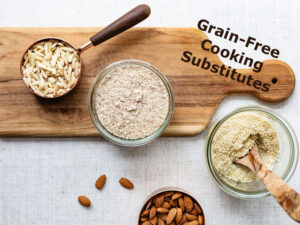A Few Simple Tips for Cutting Out Grains
The past few weeks, we’ve looked at the dangers of gluten and lectins. Going gluten free or cutting out grains and beans can sound easy in theory. Just eat meat, vegetables, fruits, and nuts. No more gluten. No more lectins. Life is great and you’ll dramatically improve your health.
But we live in a world where ultra-processed, highly palatable foods have surrounded us our entire lives. The thought of going without a cookie for the rest of your life feels dismal. The food industry has tried to rescue us from gluten by creating a gluten-free version of just about everything. But just labeling a food “gluten-free” doesn’t necessarily make a food good for you. A gluten-free Oreo is still an Oreo, and it still contains a lot of sugar, industrial seed oils, and a lot of crap.

If you want to enjoy some “modern foods” without being attacked by gluten and lectins, you can find an endless amount of recipes for making them without grains. In the past few weeks, our team at Food for Thought (Exercise Inc’s “premier” cooking show) has posted recipes for pistachio cookies, fudgy chocolate brownies, blueberry balls, and even edible cookie dough bites. All these recipes are simple and grain free…not to mention delicious.
The best approach? Cook your own grain-free versions of your favorite foods. When you cook the food, you know what it contains. You control the ingredients and the taste. Some of my favorite cook books for creating grain-free versions of my favorite dishes include The Primal Blueprint Cookbook, Primal Blueprint Quick and Easy Meals, and Primal Cravings. Mark Sisson either wrote or published all these books.
When cooking at home or buying gluten-free foods in the store, look for foods made with simple grain-free flours. Here’s the short list of flours we like.
Almond Flour
Almond flour, the number one choice for replacing wheat flour in most of our favorite dishes, is low in carbohydrates and rich in nutrients like magnesium, vitamin E, copper, and manganese. It’s also a great source of monounsaturated fats, the same fats found in avocado and olive oils.
Studies have shown almond flour reduces LDL cholesterol, and improves insulin sensitivity because of its high magnesium content.
You can often use almond flour to replace wheat flour in a 1:1 ratio, but almond flour tends to make the finished product flatter and denser.
Coconut Flour
Coconut flour has a respectable dose of fat, protein, and fiber as well as a pleasantly sweet taste. It’s also high in fiber; in fact, lab analyses show that it’s 60% fiber (56% of which is insoluble fiber). Using coconut flour in recipes can considerably lower blood sugar spikes.
When cooking with coconut flour, keep in mind its high fiber content makes it different. It sucks up any liquids it comes in contact with, which runs the risk of drying out your recipes if you’re not careful. Recipes designed for coconut flour usually include more liquid to compensate for the added fiber content.
Also, coconut floor recipes usually call for more eggs. Coconut flour does not contain gluten like wheat flour, which acts as a binding agent. Eggs play that role in the absence of gluten in coconut flour.
 Cassava Flour
Cassava Flour
Made from the whole root of the cassava plant, which is native to Mexico and South America, cassava flour has a mild flavor and fine texture that works well for cooking and baking. Cassava flour contains more fiber, protein, and minerals than wheat flour. It’s also rich in antioxidants. It’s considered a resistant starch, which means your digestive enzymes don’t break it down. Because of this, cassava flour helps with digestive health, managing blood sugar, and weight loss.
You can typically substitute cassava flour for wheat flour in a 1:1 ratio.
The grain-free flours mentioned above are often used in combination with starches to help thicken or bind the flour. Without gluten, flours lack stickiness to help bind the ingredients, so you often need to add starch. We like these three starches best.
Arrow Root Powder
Arrow root powder, a starch made from a tropical tuber native to Indonesia, is basically a white flavorless powder that works well as a thickener in sauces and gravies. Easily digestible, arrow root powder works well for children or older adults who may need gentler foods.
Arrow root powder is high in folate and higher in protein than other starches. It’s 32% resistant starch, which helps promote the development of good gut bacteria.
Potato Starch
Potato starch, another resistant starch, will do a lot to improve your gut bacteria. It doesn’t have a lot of nutrients, but it adds a light fluffy quality when used in baking. It can be combined with other gluten-free flours for a better finished product (such as almond flour, which as we mentioned above, tends to make foods flatter and denser).
Potato starch offers great results when you make gravy or need to thicken a sauce.
Tapioca Starch
Tapioca starch is simply the starch extracted from casava flour. Like other starches, it’s used as a thickener, especially in puddings.

Those represent the three grain-free flours and three starches we like to cook with. You will find them alone or in all sorts of combinations in different dishes, including the recipes we recommend. You will also find them in many gluten-free foods at the grocery store. They are all very healthy options. I recommend you keep at least a couple of the flours and a couple of the starches on hand and experiment with them as a replacement for wheat flour.
Rice flour, the one grain-free flour we recommend you avoid, unfortunately serves as a top choice by the food industry when creating gluten-free versions of our favorite foods. At around 95 on the glycemic index, rice flour effects your body similarly to sugar. Read labels—if it lists rice flour as one of the first three ingredients in your gluten-free food, it’s not a good option. Punt and go for a piece of fruit instead.
So, stock up on some of these grain-free flours and try using them in your favorite recipes at home. Or try some of our favorite recipes at Food for Thought. If you follow us on Facebook, our Food for Thought team releases a new recipe and video almost every Friday.
Stay Strong and Grain Free,
Bo Railey

